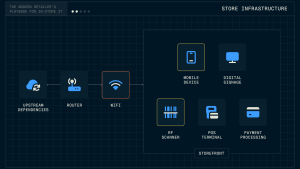Network performance monitoring is the process of collecting, analyzing, and reporting on network metrics to ensure optimal network operation and support business objectives. It involves tracking key performance indicators (KPIs) such as latency and bandwidth utilization to proactively identify and resolve network issues before they impact users or applications.
Network performance monitoring is important for several reasons:
- It ensures applications and services are delivered smoothly, improving the user experience and customer satisfaction.
- It helps you detect and respond to security breaches and malicious activity.
- It provides the data needed to demonstrate compliance with service level agreements.
In this guide, we’ll dig deeper into the “why” and “how” of network performance monitoring, including metrics to track, common challenges, and best practices for monitoring your network effectively.
How network performance monitoring works
Network performance monitoring (NPM) combines diverse data collection methods—from simple network management protocol (SNMP) queries to deep packet capture—to provide a comprehensive view of network activity.
This real-time visibility, coupled with sophisticated traffic analysis and automated alert mechanisms, empowers your IT team to proactively manage network performance and mitigate potential disruptions.
Here’s a quick breakdown of NPM in action:
- Data collection. Protocols like SNMP collect data on device health, resource utilization, and interface traffic.
- Real-time monitoring. Monitoring tools provide real-time dashboards and visualizations that display key network performance metrics.
- Traffic analysis. Network devices and special applications analyze network traffic patterns to identify anomalies, bottlenecks, and security threats.
- Alert mechanisms. Network performance management software is configured to generate alerts when network performance metrics exceed predefined thresholds.
Why businesses need to monitor networks
Why do you need to monitor networks? We touched on it at the beginning of this guide, but here’s a deeper dive into the benefits of network monitoring:
- Proactive issue resolution. Network monitoring enables you to identify and address potential problems before they escalate into major disruptions, which minimizes downtime and ensures smooth network operations.
- Enhanced security. Monitoring tools can detect anomalies that may indicate security threats, such as unauthorized access or malware activity, which allows for rapid response and mitigation of potential breaches.
- Capacity planning. Monitoring data provides valuable insights into network utilization, enabling your team to plan for future capacity needs and ensure that the network can handle increasing demands.
- Cost optimization. By optimizing network performance and preventing downtime, network monitoring helps to reduce operational costs and maximize the return on investment in network infrastructure.
Key network performance metrics to track
Understanding key network performance metrics is essential for maintaining a healthy, efficient network. Here’s a quick “tl;dr” list of these metrics followed by greater detail:
- Latency measures the delay in data transmission.
- Jitter is the variation in latency.
- Packet loss is the percentage of failed-in-transmission data packets.
- Network errors can indicate a wide range of problems.
- Bandwidth is the max amount of data transmitted over a connection.
Latency
Often measured in milliseconds (ms), latency calculates the delay in data transmission—the time it takes for a packet to travel from its source to its destination. High latency can lead to slow application performance, especially for real-time applications like VoIP and video conferencing.
For example, when a user is playing an online video game, high latency will cause noticeable delays between their actions (e.g., mouse clicks, key presses) and the game's response. Users will likely complain about “lag” and may consider the game unplayable.
Jitter
Also measured in milliseconds, jitter is the variation in latency, or the inconsistency in packet arrival times. It indicates network instability and negatively affects customer satisfaction. It can cause choppy audio and video, making real-time communication difficult.
During a VoIP phone call, for example, high jitter will cause the audio to become choppy and distorted. The user may hear fragmented words or experience sudden changes in volume, making it hard to understand the other person. In a streaming video, jitter will result in the video freezing, skipping, or having an uneven frame rate.
Packet loss
Typically expressed as a percentage, packet loss refers to the portion of data packets that fail to reach their destination. Packet loss can result in incomplete data transfers, application errors, and service disruptions.
For instance, when browsing a website, packet loss can cause pages to load partially or display errors. When downloading a file, it might result in corrupted data or a failed download. During a video call, packet loss can cause the video to freeze or break up, and the audio to cut out completely.
Network errors
Network errors encompass a wide range of issues, including interface errors, cyclic redundancy check (CRC) errors, and protocol errors. These errors can indicate hardware problems, configuration issues, or network congestion.
A user might experience frequent disconnections from a Wi-Fi network or receive error messages when trying to access network resources. They also may have trouble saving files to a network drive or experience applications crashing.
Bandwidth
Bandwidth is usually measured in bits per second (bps) and calculates the maximum amount of data that can be transmitted over a network connection in a given period. Insufficient bandwidth can lead to slow application performance and network congestion.
If a user is trying to stream a high-definition video on a network with insufficient bandwidth, the video will buffer frequently or play at a low resolution. Downloading large files will take an extremely long time. Web pages load slowly, and file transfers take a long time. Also, other applications that require network bandwidth will also run slowly.
Common challenges in network monitoring
NPM, while essential, is not without its challenges. Modern networks are increasingly complex, distributed, and dynamic, making it difficult to maintain comprehensive visibility and ensure optimal performance. These complexities can lead to significant hurdles in effectively monitoring network health and proactively addressing potential issues.
As they monitor network performance, IT teams must often face:
- A lack of visibility
- Complex network environments
- Capacity planning
- Alert fatigue
- Security vulnerabilities
Lack of visibility
Challenge: Modern networks, especially those incorporating cloud and hybrid environments, can be highly distributed and technically unclear. This creates "blind spots" where IT teams lack visibility into critical network segments or application traffic. It also makes it difficult to pinpoint the root cause of performance issues, leading to prolonged troubleshooting and increased downtime.
The lack of visibility also makes it difficult to understand the dependencies between applications and network infrastructure, hindering effective optimization and capacity planning.
Solution: Implement network monitoring tools that provide end-to-end visibility across all network segments, including cloud and on-premises infrastructure. Use technologies like flow analysis and packet capture to gain deeper insights into network traffic.
Complex network environments
Challenge: The proliferation of cloud services, virtualized infrastructure, and software-defined networking (SDN) has created highly complex network environments. Monitoring these heterogeneous environments requires tools that can collect and correlate data from diverse sources, which can be challenging to implement and manage.
The dynamic nature of these environments, which include frequent changes and updates, further complicates monitoring efforts.
Solution: Employ automated network discovery and mapping tools to visualize network topology and dependencies. Leverage AI-powered analytics to correlate data from various sources and simplify troubleshooting.
Capacity planning
Challenge: Accurately predicting future network capacity needs is a significant challenge, especially in rapidly growing organizations. Overprovisioning can lead to wasted resources, while underprovisioning can result in performance bottlenecks and service disruptions.
Effective capacity planning requires accurate data on network utilization, traffic patterns, and application demands, which can be difficult to obtain and analyze.
Solution: Use network monitoring tools that provide historical trend analysis and predictive analytics to forecast future capacity requirements. Regularly assess network utilization and adjust resources accordingly.
Alert fatigue
Challenge: Network monitoring tools can generate a large volume of alerts, many of which may be false positives or low-priority notifications. This can lead to "alert fatigue," where IT teams become overwhelmed and desensitized to alerts, potentially missing critical issues.
Effective alert management requires intelligent filtering, correlation, and prioritization to ensure that only relevant and actionable alerts are delivered.
Solution: Implement intelligent alert management systems that use dynamic baselines and anomaly detection to reduce false positives. Integrate alert systems with IT service management tools for automated ticket creation and escalation.
Security vulnerabilities
Challenge: Network monitoring plays a crucial role in security, but it also introduces potential security risks of its own.
For example, monitoring tools can collect sensitive network data, which must be protected from unauthorized access and breaches. However, monitoring systems themselves can be targets of cyberattacks, requiring robust security measures to ensure their integrity and availability.
Solution: Institute network monitoring tools with security analytics capabilities to detect anomalous traffic patterns and potential security breaches. In addition, use network flow data to identify and investigate security incidents.
Best practices for monitoring your network effectively
Effective network monitoring is paramount for maintaining optimal performance and preventing costly disruptions. By adhering to established best practices, your IT team can proactively identify and resolve issues, optimize resource allocation, and ensure seamless user experiences.
1. Establish a baseline for network performance
Capture historical data on key metrics like latency, bandwidth, and packet loss to understand normal network behavior. This baseline serves as a reference point for detecting anomalies and deviations that may indicate performance issues. Regularly update the baseline to reflect changes in network traffic patterns and infrastructure.
2. Use real-time monitoring tools
Implement tools that provide continuous visibility into network performance, enabling immediate detection of bottlenecks and anomalies. Real-time performance monitoring tools give IT teams a unified platform that allows for quick responses to performance degradation, minimizing potential disruptions and aiding in rapid troubleshooting.
3. Implement proactive automation
Automate routine network tasks like service restarts or traffic rerouting based on predefined thresholds or detected anomalies. This reduces manual intervention, speeds up issue resolution, and minimizes downtime. Integrate automation with alerting for immediate responses. Employ orchestration tools to manage complex workflows and configurations.
4. Regularly audit and update network infrastructure
Regularly audit network infrastructure to identify vulnerabilities, outdated hardware, and configuration errors. Conduct periodic security assessments and performance tests. Update firmware, software, and hardware to the latest versions to patch security holes and improve functionality.
Document all changes and configurations to maintain accurate records. In addition, implement a change management process to control and track updates, minimizing disruptions.
These actions ensure optimal performance, security, and compliance, while preventing unexpected failures and security breaches.
5. Document network configurations and processes
Maintain comprehensive documentation of network configurations, diagrams, and processes. This includes IP addressing, device configurations, network topology, and troubleshooting procedures. Accurate documentation enables efficient troubleshooting, knowledge sharing, and consistent network management, especially during outages or staff changes.
Monitoring network performance is critical for maintaining optimal network health, ensuring business continuity, and delivering positive user experiences. By tracking key metrics, understanding potential challenges, and implementing an actionable set of best practices, your IT team can proactively manage its networks.
But your team needs the right tools to fully realize the benefits of network monitoring.
New Relic network performance monitoring removes the guesswork in identifying where performance issues start:
- Real-time monitoring provides instant visibility into application and infrastructure performance, including network-related metrics, to quickly identify and address issues.
- AI-powered alerts leverage anomaly detection and dynamic baselines to minimize alert fatigue and deliver actionable insights into network and application performance deviations.
- Scalability is built into the tool, so it can handle massive data volumes from complex, distributed environments, ensuring consistent monitoring as your network and applications grow.
- Customizable dashboards offer flexible ways to visualize key network and application performance indicators, allowing for tailored monitoring views and reporting.
- Integration capabilities allow for seamless connection with various IT tools and platforms, enabling unified monitoring and streamlined workflows across your entire technology stack.
Learn more about how New Relic’s network performance management software can help your IT team keep your network optimized around the clock. Contact us today.
The views expressed on this blog are those of the author and do not necessarily reflect the views of New Relic. Any solutions offered by the author are environment-specific and not part of the commercial solutions or support offered by New Relic. Please join us exclusively at the Explorers Hub (discuss.newrelic.com) for questions and support related to this blog post. This blog may contain links to content on third-party sites. By providing such links, New Relic does not adopt, guarantee, approve or endorse the information, views or products available on such sites.



